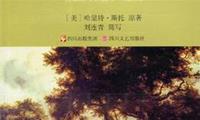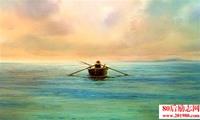老人與海讀後感50字(一)
老人既把魚當做朋友,又當成對手。他讚歎對手的強大,同時又毫不畏懼,可以看出老人內心磊落、蔑視困難的個性。當鯊魚來臨時,老人又臨危不亂,猛擊鯊魚,大魚雖然被吃了,但老人的精神是值得我們學習的!
老人與海讀後感50字(二)
第一:老人那不放棄、不氣餒一直樂觀的去面對生活,也不去理睬別人嘲笑和譏諷。但我有時做錯了事,別人只要嘲笑一下我就不繼續辦下去,也對此失去了再辦下去的信心。
第二:抓到魚後,勇敢地去和鯊魚搏鬥,毫不畏懼。堅強勇敢的去面對困難。
老人的這兩種精神不正是我們應該學習嗎?
老人與海讀後感50字(三)
看到這些,我深深的被老漁夫這種永不言敗,毫不氣餒,樂觀向上的精神所感動。想想自己平時在學校上的妥協,真是慚愧。老漁夫的這種精神,正是我身上所缺少的,我要時刻謹記老漁夫的這種精神,作為自己學習的動力,勝不驕,敗不餒,做一個永不言棄的人!
老人與海讀後感50字(四)
以後,我要學習老人的可貴精神,如果遇到了困難,就要向老人一樣,去努力、去堅持的把困難解決掉。這樣,世界上就沒有任何困難來當阻擋你前進的步伐了。
老人與海讀後感50字(五)
老漁夫最終還是勝利了,是因為他說的一句話:“一個人並不是生來就要被打敗的,
老人與海讀後感50字(六)
老人多麼有毅力啊!在茫茫大海中獨自一人進行了一場場戰鬥,但他還是頑強的堅持下來。雖然在海中他也面臨成為鯊魚口中美食的危險,但他用自己的冷靜與智慧,把鯊魚打得節節後退,老人雖然最終沒有帶回魚來,但那只是肉體上的失敗,
老人與海讀後感300字(一)
老漁夫桑提亞哥在海上連續84天沒有捕到魚。起初,有一個叫曼諾林的男孩跟他一道出海,可是過了40天還沒有釣到魚,孩子就被父母安排到另一條船上去了,因為他們認為孩子跟著老頭不會交好運。第85天,老頭兒一清早就把船劃出很遠,他出乎意料地釣到了一條比船還大的馬林魚。老頭兒和這條魚周旋了兩天,終於叉中了它。但受傷的魚在海上留下了一道腥蹤,引來無數鯊魚的爭搶,老人奮力與鯊魚搏鬥,但回到海港時,馬林魚只剩下一副巨大的骨架,老人也精疲力盡地一頭栽倒在陸地上。孩子來看老頭兒,
桑提亞哥是海明威所崇尚的完美的人的象徵:堅強、寬厚、仁慈、充滿愛心,即使在人生的角鬥場上失敗了,面對不可逆轉的命運,他仍然是精神上的強者,是“硬漢子”。“硬漢子”是海明威作品中經常表現的主題,
老人與海讀後感300字(二)
老人與海是美國著名的小說家海名威寫的,本文主要講了:一位古巴老漁夫聖地牙哥在連續84天沒捕到一條魚的情況下決定獨自去所有漁夫們此前沒有去過的深海打魚,以證明自己的能力與勇氣。在第85天聖地牙哥釣到一條大馬林魚,經過艱苦與搏鬥,克服了重重困難,他終於在第88天早晨,將魚叉刺進了這條魚的心臟。再返回的途中,老人又遇到了鯊魚一次接一次的襲擊,他用魚叉、船槳和刀子奮力反擊。最後,當他駕駛小船回到港口時,
在連續84天沒捕到魚的情況下,老人沒有喪失自信;在質疑下,老人沒有喪失自信;在嘲笑中,老人沒有喪失自信。他的自信絕對是自信,是不以環境變化而變化的自信,是不用與其他人比較的自信。在老人的生存哲學中,即使遭遇到了極點的揹運人也只能自信。
老人被打敗了,用老人自己的話來說是。從物質的角度來看,老漁夫並不是最終的勝利者,因為,儘管他開始戰勝了大馬林魚,但是,最終大馬林魚還是被鯊魚給吃了,他只是帶著大馬林魚的白骨架子回到岸上,也就是說,鯊魚才是勝利者。可是,從精神的家角度來看,老漁夫就是勝利者,因為他始終沒有向大海、大馬林魚,更沒有向鯊魚妥協和投降。就如大音樂家貝多芬所說“我可以被摧毀,但我不能被征服”。
老人勇敢,自信難道不是我們學習的榜樣嗎?
老人與海讀後感300字(三)
我讀了美國著名作家海明威的小說《老人與海》,十分佩服小說中老漁夫的意志,他讓我懂得了一個人一定要有堅持不懈的精神,才能獲得成功。小說描寫的是一個年近六旬的老漁夫,在一次單身出海打魚時,釣到了一條大魚,卻拉不上來。老漁夫同魚周旋了幾天後,才發現這是一條超過自己漁船數倍的大馬林魚,雖然明知很難取勝,但仍不放棄。()後來又因大馬林魚傷口上的魚腥味引來了幾群鯊魚搶食,但老人仍不願就這樣放棄,最終突出重圍,將大魚帶回了漁港,讓其他漁夫佩服不已。
老人與海讀後感300字(四)
今天,我把《老人與海》這一本書讀完了,這一本書主要講了一位老人在海上釣魚,可他一連84沒有釣上一條魚。
其實這本書我讀完後,並沒有完全理解這本書的意思,於是我就問了媽媽,媽媽就又給我講了一遍,我才明白了一些。
老人一連84天沒有任何收穫,可是他沒有放棄,仍然不停的給自己加油鼓勁,最後他決定去深海裡捕捉一條大大的魚,於是他就出發了。最後雖然他釣到了一條好大的魚,但在在往回返的時候卻被大鯊魚給吃光了,只留下了一條巨大的魚骨頭。他很傷心。
看完這本書,我心裡有點難過。我覺得老人很可憐。
老人與海讀後感英文版
When I was a middle school student, I’ve finished this book in Chinese.But when I read it in English,I really gain something new both in the way of expression and the spirit it shows to us.May be different ages to read the same book we will learn different things from it.At least, for my part, that is true.
Firstly,I would like to review some information about this book.Such as the background,major characters and the topic of it.
The Old Man and the Sea is a story by Ernest Hemingway, written in Cuba in 1951 and published in 1952. It was the last major work of fiction to be produced by Hemingway and published in his lifetime. One of his most famous works, it centers upon Santiago, an aging Cuban fisherman who struggles with a giant marlin far out in the Gulf Stream.
The Old Man and the Sea served to reinvigorate Hemingway's literary reputation and prompted a reexamination of his entire body of work. The novella was initially received with much popularity; it restored many readers' confidence in Hemingway's capability as an author. Its publisher, Scribner's, on an early dust jacket, called the novella a "new classic," and many critics favorably compared it with such works as William Faulkner's "The Bear" and Herman Melville's Moby-Dick.
This book gives me a deep impression especially the description about the man’s braveness and persistence.
In this book, in order to suggest the profundity of the old man’s sacrifice and the glory that derives from it, Hemingway purposefully likens Santiago to Christ, who, according to Christian theology, gave his life for the greater glory of humankind. Crucifixion imagery is the most noticeable way in which Hemingway creates the symbolic parallel between Santiago and Christ. When Santiago’s palms are first cut by his fishing line, the reader cannot help but think of Christ suffering his stigmata. Later, when the sharks arrive, Hemingway portrays the old man as a crucified martyr, saying that he makes a noise similar to that of a man having nails driven through his hands. Furthermore, the image of the old man struggling up the hill with his mast across his shoulders recalls Christ’s march toward Calvary. Even the position in which Santiago collapses on his bed—face down with his arms out straight and the palms of his hands up—brings to mind the image of Christ suffering on the cross. Hemingway employs these images in the final pages of the novella in order to link Santiago to Christ, who exemplified transcendence by turning loss into gain, defeat into triumph, and even death into renewed life.
The major characters in this book are also vivid and lively.
Santiago?,the old man of the novella’s title, Santiago is a Cuban fisherman who has had an extended run of bad luck. Despite his expertise, he has been unable to catch a fish for eighty-four days. He is humble, yet exhibits a justified pride in his abilities. His knowledge of the sea and its creatures, and of his craft, is unparalleled and helps him preserve a sense of hope regardless of circumstance.
The marlin?,Santiago hooks the marlin, which we learn at the end of the novella measures eighteen feet, on the first afternoon of his fishing expedition. Manolin?,a boy presumably in his adolescence, Manolin is Santiago’s apprentice and devoted attendant. The old man first took him out on a boat when he was merely five years old. Due to Santiago’s recent bad luck, Manolin’s parents have forced the boy to go out on a different fishing boat. Manolin, however, still cares deeply for the old man, to whom he continues to look as a mentor.
Joe DiMaggio, although DiMaggio never appears in the novel, he plays a significant role nonetheless. Santiago worships him as a model of strength and commitment, and his thoughts turn toward DiMaggio whenever he needs to reassure himself of his own strength. Perico ?,Perico, the reader assumes, owns the bodega in Santiago’s village. He never appears in the novel, but he serves an important role in the fisherman’s life by providing him with newspapers that report the baseball scores. This act establishes him as a kind man who helps the aging Santiago.
Martin,like Perico, Martin, a café owner in Santiago’s village, does not appear in the story. The reader learns of him through Manolin, who often goes to Martin for Santiago’s supper. As the old man says, Martin is a man of frequent kindness who deserves to be repaid.
From the very first paragraph, Santiago is characterized as someone struggling against defeat. He has gone eighty-four days without catching a fish—he will soon pass his own record of eighty-seven days. Almost as a reminder of Santiago’s struggle, the sail of his skiff resembles “the flag of permanent defeat.” But the old man refuses defeat at every turn: he resolves to sail out beyond the other fishermen to where the biggest fish promise to be. He lands the marlin, tying his record of eighty-seven days after a brutal three-day fight, and he continues to ward off sharks from stealing his prey, even though he knows the battle is useless.
Because Santiago is pitted against the creatures of the sea, some readers choose to view the tale as a chronicle of man’s battle against the natural world, but the novella is, more accurately, the story of man’s place within nature. Both Santiago and the marlin display qualities of pride, honor, and bravery, and both are subject to the same eternal law: they must kill or be killed. As Santiago reflects when he watches the weary warbler fly toward shore, where it will inevitably meet the hawk, the world is filled with predators, and no living thing can escape the inevitable struggle that will lead to its death. Santiago lives according to his own observation: “man is not made for defeat . . . [a] man can be destroyed but not defeated.” In Hemingway’s portrait of the world, death is inevitable, but the best men (and animals) will nonetheless refuse to give in to its power. Accordingly, man and fish will struggle to the death, just as hungry sharks will lay waste to an old man’s trophy catch.
The novel suggests that it is possible to transcend this natural law. In fact, the very inevitability of destruction creates the terms that allow a worthy man or beast to transcend it. It is precisely through the effort to battle the inevitable that a man can prove himself. Indeed, a man can prove this determination over and over through the worthiness of the opponents he chooses to face. Santiago finds the marlin worthy of a fight, just as he once found “the great negro of Cienfuegos” worthy. HSantiago, though destroyed at the end of the novella, is never defeated. Instead, he emerges as a hero. Santiago’s struggle does not enable him to change man’s place in the world. Rather, it enables him to meet his most dignified destiny.
While it is certainly true that Santiago’s eighty-four-day run of bad luck is an affront to his pride as a masterful fisherman, and that his attempt to bear out his skills by sailing far into the gulf waters leads to disaster, Hemingway does not condemn his protagonist for being full of pride. On the contrary, Santiago stands as proof that pride motivates men to greatness. Because the old man acknowledges that he killed the mighty marlin largely out of pride, and because his capture of the marlin leads in turn to his heroic transcendence of defeat, pride becomes the source of Santiago’s greatest strength. Without a ferocious sense of pride, that battle would never have been fought, or more likely, it would have been abandoned before the end.
Santiago’s pride also motivates his desire to transcend the destructive forces of nature. Throughout the novel, no matter how baleful his circumstances become, the old man exhibits an unflagging determination to catch the marlin and bring it to shore. When the first shark arrives, Santiago’s resolve is mentioned twice in the space of just a few paragraphs. Even if the old man had returned with the marlin intact, his moment of glory, like the marlin’s meat, would have been short-lived. The glory and honor Santiago accrues comes not from his battle itself but from his pride and determination to fight.
Santiago dreams his pleasant dream of the lions at play on the beaches of Africa three times. The first time is the night before he departs on his three-day fishing expedition, the second occurs when he sleeps on the boat for a few hours in the middle of his struggle with the marlin, and the third takes place at the very end of the book. In fact, the sober promise of the triumph and regeneration with which the novella closes is supported by the final image of the lions. Because Santiago associates the lions with his youth, the dream suggests the circular nature of life. Additionally, because Santiago imagines the lions, fierce predators, playing, his dream suggests a harmony between the opposing forces—life and death, love and hate, destruction and regeneration—of nature.
This book gives me courage of conquering all kinds of difficulties .And I have the belief that the most beautiful thing is the process that we make our best to achieve our dream,and never say give up .
更沒有向鯊魚妥協和投降。就如大音樂家貝多芬所說“我可以被摧毀,但我不能被征服”。老人勇敢,自信難道不是我們學習的榜樣嗎?
老人與海讀後感300字(三)
我讀了美國著名作家海明威的小說《老人與海》,十分佩服小說中老漁夫的意志,他讓我懂得了一個人一定要有堅持不懈的精神,才能獲得成功。小說描寫的是一個年近六旬的老漁夫,在一次單身出海打魚時,釣到了一條大魚,卻拉不上來。老漁夫同魚周旋了幾天後,才發現這是一條超過自己漁船數倍的大馬林魚,雖然明知很難取勝,但仍不放棄。()後來又因大馬林魚傷口上的魚腥味引來了幾群鯊魚搶食,但老人仍不願就這樣放棄,最終突出重圍,將大魚帶回了漁港,讓其他漁夫佩服不已。
老人與海讀後感300字(四)
今天,我把《老人與海》這一本書讀完了,這一本書主要講了一位老人在海上釣魚,可他一連84沒有釣上一條魚。
其實這本書我讀完後,並沒有完全理解這本書的意思,於是我就問了媽媽,媽媽就又給我講了一遍,我才明白了一些。
老人一連84天沒有任何收穫,可是他沒有放棄,仍然不停的給自己加油鼓勁,最後他決定去深海裡捕捉一條大大的魚,於是他就出發了。最後雖然他釣到了一條好大的魚,但在在往回返的時候卻被大鯊魚給吃光了,只留下了一條巨大的魚骨頭。他很傷心。
看完這本書,我心裡有點難過。我覺得老人很可憐。
老人與海讀後感英文版
When I was a middle school student, I’ve finished this book in Chinese.But when I read it in English,I really gain something new both in the way of expression and the spirit it shows to us.May be different ages to read the same book we will learn different things from it.At least, for my part, that is true.
Firstly,I would like to review some information about this book.Such as the background,major characters and the topic of it.
The Old Man and the Sea is a story by Ernest Hemingway, written in Cuba in 1951 and published in 1952. It was the last major work of fiction to be produced by Hemingway and published in his lifetime. One of his most famous works, it centers upon Santiago, an aging Cuban fisherman who struggles with a giant marlin far out in the Gulf Stream.
The Old Man and the Sea served to reinvigorate Hemingway's literary reputation and prompted a reexamination of his entire body of work. The novella was initially received with much popularity; it restored many readers' confidence in Hemingway's capability as an author. Its publisher, Scribner's, on an early dust jacket, called the novella a "new classic," and many critics favorably compared it with such works as William Faulkner's "The Bear" and Herman Melville's Moby-Dick.
This book gives me a deep impression especially the description about the man’s braveness and persistence.
In this book, in order to suggest the profundity of the old man’s sacrifice and the glory that derives from it, Hemingway purposefully likens Santiago to Christ, who, according to Christian theology, gave his life for the greater glory of humankind. Crucifixion imagery is the most noticeable way in which Hemingway creates the symbolic parallel between Santiago and Christ. When Santiago’s palms are first cut by his fishing line, the reader cannot help but think of Christ suffering his stigmata. Later, when the sharks arrive, Hemingway portrays the old man as a crucified martyr, saying that he makes a noise similar to that of a man having nails driven through his hands. Furthermore, the image of the old man struggling up the hill with his mast across his shoulders recalls Christ’s march toward Calvary. Even the position in which Santiago collapses on his bed—face down with his arms out straight and the palms of his hands up—brings to mind the image of Christ suffering on the cross. Hemingway employs these images in the final pages of the novella in order to link Santiago to Christ, who exemplified transcendence by turning loss into gain, defeat into triumph, and even death into renewed life.
The major characters in this book are also vivid and lively.
Santiago?,the old man of the novella’s title, Santiago is a Cuban fisherman who has had an extended run of bad luck. Despite his expertise, he has been unable to catch a fish for eighty-four days. He is humble, yet exhibits a justified pride in his abilities. His knowledge of the sea and its creatures, and of his craft, is unparalleled and helps him preserve a sense of hope regardless of circumstance.
The marlin?,Santiago hooks the marlin, which we learn at the end of the novella measures eighteen feet, on the first afternoon of his fishing expedition. Manolin?,a boy presumably in his adolescence, Manolin is Santiago’s apprentice and devoted attendant. The old man first took him out on a boat when he was merely five years old. Due to Santiago’s recent bad luck, Manolin’s parents have forced the boy to go out on a different fishing boat. Manolin, however, still cares deeply for the old man, to whom he continues to look as a mentor.
Joe DiMaggio, although DiMaggio never appears in the novel, he plays a significant role nonetheless. Santiago worships him as a model of strength and commitment, and his thoughts turn toward DiMaggio whenever he needs to reassure himself of his own strength. Perico ?,Perico, the reader assumes, owns the bodega in Santiago’s village. He never appears in the novel, but he serves an important role in the fisherman’s life by providing him with newspapers that report the baseball scores. This act establishes him as a kind man who helps the aging Santiago.
Martin,like Perico, Martin, a café owner in Santiago’s village, does not appear in the story. The reader learns of him through Manolin, who often goes to Martin for Santiago’s supper. As the old man says, Martin is a man of frequent kindness who deserves to be repaid.
From the very first paragraph, Santiago is characterized as someone struggling against defeat. He has gone eighty-four days without catching a fish—he will soon pass his own record of eighty-seven days. Almost as a reminder of Santiago’s struggle, the sail of his skiff resembles “the flag of permanent defeat.” But the old man refuses defeat at every turn: he resolves to sail out beyond the other fishermen to where the biggest fish promise to be. He lands the marlin, tying his record of eighty-seven days after a brutal three-day fight, and he continues to ward off sharks from stealing his prey, even though he knows the battle is useless.
Because Santiago is pitted against the creatures of the sea, some readers choose to view the tale as a chronicle of man’s battle against the natural world, but the novella is, more accurately, the story of man’s place within nature. Both Santiago and the marlin display qualities of pride, honor, and bravery, and both are subject to the same eternal law: they must kill or be killed. As Santiago reflects when he watches the weary warbler fly toward shore, where it will inevitably meet the hawk, the world is filled with predators, and no living thing can escape the inevitable struggle that will lead to its death. Santiago lives according to his own observation: “man is not made for defeat . . . [a] man can be destroyed but not defeated.” In Hemingway’s portrait of the world, death is inevitable, but the best men (and animals) will nonetheless refuse to give in to its power. Accordingly, man and fish will struggle to the death, just as hungry sharks will lay waste to an old man’s trophy catch.
The novel suggests that it is possible to transcend this natural law. In fact, the very inevitability of destruction creates the terms that allow a worthy man or beast to transcend it. It is precisely through the effort to battle the inevitable that a man can prove himself. Indeed, a man can prove this determination over and over through the worthiness of the opponents he chooses to face. Santiago finds the marlin worthy of a fight, just as he once found “the great negro of Cienfuegos” worthy. HSantiago, though destroyed at the end of the novella, is never defeated. Instead, he emerges as a hero. Santiago’s struggle does not enable him to change man’s place in the world. Rather, it enables him to meet his most dignified destiny.
While it is certainly true that Santiago’s eighty-four-day run of bad luck is an affront to his pride as a masterful fisherman, and that his attempt to bear out his skills by sailing far into the gulf waters leads to disaster, Hemingway does not condemn his protagonist for being full of pride. On the contrary, Santiago stands as proof that pride motivates men to greatness. Because the old man acknowledges that he killed the mighty marlin largely out of pride, and because his capture of the marlin leads in turn to his heroic transcendence of defeat, pride becomes the source of Santiago’s greatest strength. Without a ferocious sense of pride, that battle would never have been fought, or more likely, it would have been abandoned before the end.
Santiago’s pride also motivates his desire to transcend the destructive forces of nature. Throughout the novel, no matter how baleful his circumstances become, the old man exhibits an unflagging determination to catch the marlin and bring it to shore. When the first shark arrives, Santiago’s resolve is mentioned twice in the space of just a few paragraphs. Even if the old man had returned with the marlin intact, his moment of glory, like the marlin’s meat, would have been short-lived. The glory and honor Santiago accrues comes not from his battle itself but from his pride and determination to fight.
Santiago dreams his pleasant dream of the lions at play on the beaches of Africa three times. The first time is the night before he departs on his three-day fishing expedition, the second occurs when he sleeps on the boat for a few hours in the middle of his struggle with the marlin, and the third takes place at the very end of the book. In fact, the sober promise of the triumph and regeneration with which the novella closes is supported by the final image of the lions. Because Santiago associates the lions with his youth, the dream suggests the circular nature of life. Additionally, because Santiago imagines the lions, fierce predators, playing, his dream suggests a harmony between the opposing forces—life and death, love and hate, destruction and regeneration—of nature.
This book gives me courage of conquering all kinds of difficulties .And I have the belief that the most beautiful thing is the process that we make our best to achieve our dream,and never say give up .







